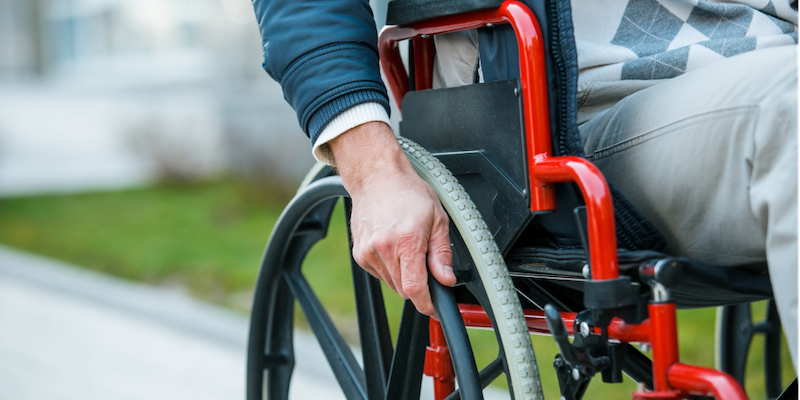Positioning your rear wheelchair wheel is one of the most important aspects of fitting your chair. These adjustments depend on the usage of the chair and the wheelchair user’s needs and preferences.
Vertical & Horizontal Orientation
When first adjusting a wheelchair, you will need to think about the vertical and horizontal positioning of the rear wheels. Both of these have an impact on wheelchair comfort and steering capabilities.
Vertical positioning affects the user’s seat-to-floor height. For standard wheelchairs, it’s around 18 to 20 inches high. If the seat is too high, the user’s elbows and shoulders will be in a state of tension.
This is because they’re bent and elevated for extended periods to propel the chair. Excessive height also makes transferring in and out of the chair more difficult.
Conversely, if the seat is too low, it can be difficult to reach the hand rims on the rear wheel. The person then needs to push the wheels more often to go a certain distance. This leads to overworking those muscles and straining them.
Horizontal orientation is the adjustment of the rear wheel either backward or forward. Altering horizontal orientation greatly affects the center of gravity and the amount of weight put on each wheel.
The most efficient position for the rear wheel is forward. This position places the center of gravity backward and decreases the amount of weight on the front wheels, also known as casters.
A forward position makes the chair easier to propel and allows for greater maneuverability. Stability will decrease, but for those who generally use self-propulsion, it has greater benefits.
For wheelchair users who are often pushed by someone else, a backward positioning might be better. It’s more stable, though the front casters will bear more weight. It also increases rolling resistance, which is an effect where a wheelchair user will have more difficulty pushing the chair.
Optimal Position for the Rear Wheelchair Wheel
The positioning of the rear wheel affects the stability and maneuverability. The optimal position is with the rear wheel forward, and the seat-to-floor height at the correct measurement.
You should be able to reach the wheel hub with the tip of your middle finger. Then be able to comfortably place your arms at a 100-120-degree angle between your forearm and upper arm.
Other Positioning Issues
The person using the wheelchair’s sitting position can also impact their usage of the rear wheel. The correct positioning for someone in a wheelchair is a neutral position. This is sitting with a straight spine, legs parallel to each other and the seat, hip bones level, and feet supported.
If the person using the chair is improperly positioned, this can negatively affect their ability to propel themselves. It may also coincide with the misalignment of the vertical and/or horizontal positions.
The pelvis pulling forward in a seat with the person’s head tilting toward the ceiling is anterior pelvic tilt. Sitting like this can lead to difficulties with navigation and other issues.
Posterior pelvic tilt is the opposite when the pelvis is tipped backward and the torso forward. This can cause problems as users may be unable to reach the wheel hub without tipping too far forward or placing undue strain on their arms.
Pelvic migration and obliquity can both lead to difficulties using the rear wheel. Migration is the term for when a person’s pelvis slides forward while sitting and is sometimes caused by self-propulsion. This makes it all the more important to have the proper real wheel alignment that doesn’t force the user to shift or readjust in the seat.
Pelvic obliquity occurs when one side of the pelvis is higher than the other in the chair. One arm may be higher than the arm because of this. Even with the rear wheels properly aligned, the arms being uneven may lead to an inefficiency in power and uneven stress on the shoulders and arms.
Athletics
For athletes in wheelchairs, the rear wheels are a consideration for their performance. Various sports have different chairs built for them.
The main difference between sports chairs and everyday chairs is the camber. Camber is the measurement of the angle of a set of wheels in relation to the ground.
Increasing the camber widens the width of the wheelchair. In turn, the chair is more stable and the ride is smoother. This allows for greater maneuverability, allowing for faster acceleration and quicker turns.
Greater camber can be helpful for young children, as steering a wheelchair is easier when the wheels are more accessible.
With the rear wheels turned inward, the hand rim is in a more natural place for a push. This decreases the amount of shoulder strain during propulsion. Decreased shoulder strain is especially important for racing and other self-propelled sports.
Adding camber does have some disadvantages. Wheels that are turned either inward or outward can create rolling resistance. Secondly, although it may be an advantage for some, it’s important to consider that for every 2 degrees of camber added, the overall width of the chair is increased by approximately 1 inch.
This can be useful in that the wheel will hit an obstacle before the user’s hands when navigating tight spaces. But on the downside, it can also make navigating those same spaces difficult if they’re not wide enough for cambered wheels.
A wheelchair with a large degree of camber can cause also the tires to wear at an advanced degree. It may also rub against the side guards, armrest, or user and cause wear or discomfort.
The Value of Mobility
The proper rear wheelchair wheel position allows you to comfortably and efficiently propel your chair. Finding the right position for your wheelchair, especially for those concerned about body positioning issues or sports, is vital to get the most out of your mobility aid.
To take advantage of their variety of complex power wheelchairs and get an in-home assessment, explore Freedom Mobility Center’s repair and services in GA, NC, SC, VA, and WV.

